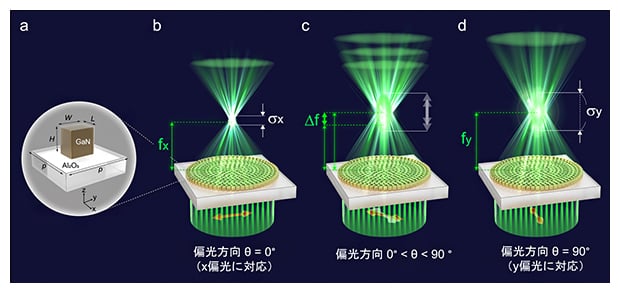Researchers Develop a Flat Metalens That Can Change Its Focal Length
![]()
An international group of researchers has developed a metalens that is able to have its focal length changed and controlled using polarized light.
As explained over the past few years as the technology has advanced, metalenses are flat surfaces that are designed to replace full-size optics using a wholly different method of bending and controlling light. Basically, metalenses reduce the typically large and complicated optical structure of a standard camera lens and compress it into a much smaller system that bends light using nanoparticles and metasurfaces instead of curved optics.
Right now, it doesn’t often seem to be the goal of metalens developers to replace full-size camera optics, but rather to focus efforts — pun intended — on devices with small cameras like smartphones, cars, virtual reality and augmented reality headsets, and other similar devices. One immediate benefit of a fully operational metalens would be to eliminate the “camera bump” on smartphones. Without the need for stacked optics there, the amount of space that is taken up by a camera would be significantly reduced.
Metalens technology is a rapidly evolving space that is being developed by groups ranging in size from university-led researchers to as large as whole companies based in the technology like Metalenz. It has even attracted major players like Canon.
This latest advancement comes from Japanese-based research institute Rikan, as seen by Digicame-Info. A team there has succeeded in creating a metalens whose focal length can be changed by adjusting the polarization direction of incident light.

“A metalens is a lens composed of an artificial structure on the scale of nanometers (nm, 1 nm is one billionth of a meter), which is finer than the wavelength of light, and is an extremely thin lens with a thickness of only 750 nanometers. By designing the nanostructures that make up this metalens to respond only to specific polarizations of light, we were able to freely change the focal length of the lens by changing the polarization direction of the light,” Rikan’s researchers explain.
“Through this research, we have created a compact, ultra-thin lens that can quickly change the focal position and zoom ratio. Such lenses can be applied in a wide range of fields, including smartphone cameras, augmented reality displays, microscopes, and medical optical equipment such as binoculars and endoscopes. Combined with the flexibility of metalens design, which allows controlling the optical function by designing the shape of the artificial structure, it is expected that high-performance optical devices that are precisely customized to the requirements of specific applications will be realized.”
Rikan’s research team’s full results can be seen on the organization’s website and the group says that the results they have achieved are expected to contribute to the development of extremely compact, high-performance optical devices. In just a few years, metalenses have gone from only able to produce blurry images of objects to dramatically sharper and, now, are able to shift their focal length without any moving parts. Watch this space closely, as it will no doubt continue to accelerate.
Image credits: Header image is an example of a large sheet of metalenses, courtesy of Metalenz